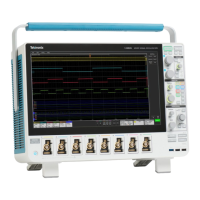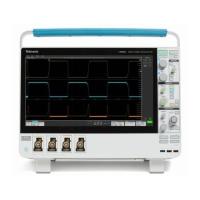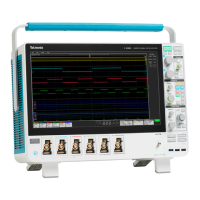If the Signal Type is Data. The application calculates Data TIE measurement using the following equation:
Where:
TIEData is the data time interval error.
TData is the Mid reference crossing time in either direction.
T'Data is the corresponding edge time for the specified reference clock.
The subscript k is used to indicate that there is one measurement per actual edge.
T/nT Ratio measurement algorithm
T/nT Ratio is the ratio in dB of the midpoint level of the 1st bit after each transition to the midpoints of the 2nd and subsequent
non-transition bit levels prior to the next transition. This measurement is made for each non-transition bit in the record.
DCD
Duty Cycle Distortion (DCD) is the peak-to-peak amplitude for that portion of the deterministic jitter directly correlated with signal
polarity, that is the difference between the mean positive edge displacement versus that on negative edges. A single DCD value
is determined for each acquisition, by means of RJ-DJ separation analysis.
DDJ
Data-Dependent Jitter (DDJ) is the peak-to-peak amplitude for that portion of the deterministic jitter directly correlated with the
data pattern in the waveform. A single DDJ value is determined for each acquisition, by means of RJ-DJ separation analysis.
DJ
Deterministic Jitter (DJ) is the peak-to-peak amplitude for all timing errors that follow deterministic behavior. A single DJ value is
determined for each acquisition, by means of RJ-DJ separation analysis.
Dual Dirac deterministic jitter
Dual Dirac Deterministic Jitter (DJ–δδ) the peak-to-peak magnitude for all timing errors exhibiting deterministic behavior,
calculated based on a simplifying assumption that the histogram of all deterministic jitter can be modeled as a pair of equal
magnitude dirac functions (impulses). A single DJ–δδ value is determined for each acquisition, by means of RJ-DJ separation
analysis.
Measurement algorithms
456 MSO54, MSO56, MSO58, MSO58LP, MSO64 Help

